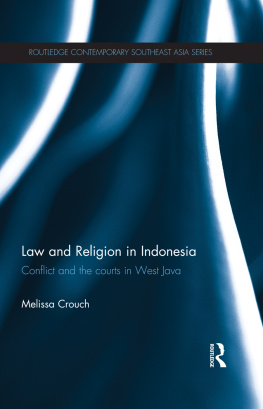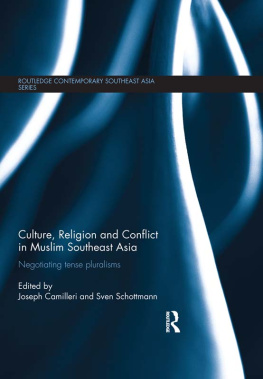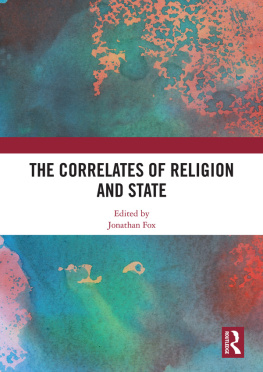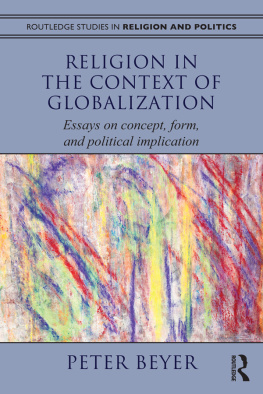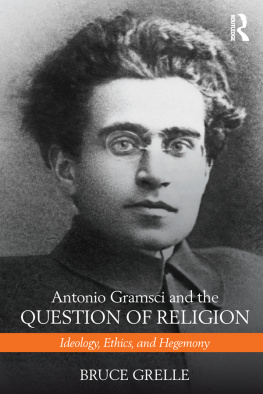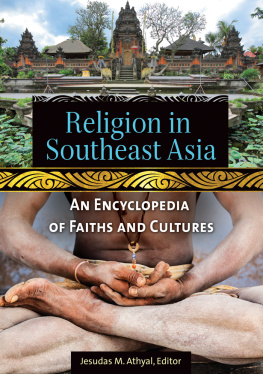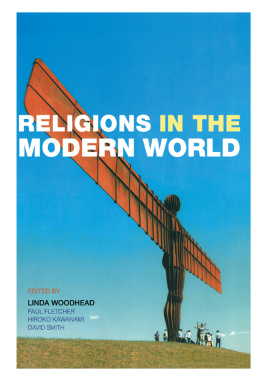THE
RELIGION
OF
JAVA
THE
RELIGION
OF
JAVA
CLIFFORD
GEERTZ
THE UNIVERSITY OF CHICAGO PRESS CHICAGO AND LONDON
The University of Chicago Press, Chicago 60637 The University of Chicago Press, Ltd., London
Copyright 1960 by The Free Press, a Corporation
All rights reserved. Published 1960
Phoenix Edition 1976
Printed in the United States of America
90 89 88 87 86 5 6 7
International Standard Book Number: 0-226-28510-3 Library of Congress Catalog Card Number: 75-18746
For the Wedono, the Modin,
and my cibangan Landlord
Niiwun Pangestunipun Sedaja Kalepatan Kula
Foreword
This is the first of a series of descriptive monographs about various aspects of contemporary life in an actual and in many respects typical place in east central Java. For obvious reasons, the names given to locations and persons are fictitious, but the descriptions are based on direct observation.
The other monographs in this series will report on Village Life and Rural Economy (Robert Jay), The Market (Alice Dewey), Administrative Organization (Donald Fagg), Family Organization and Socialization (Hil-dred Geertz), and The Chinese Community (Edward Ryan).
The field work on which these monographs are based was conceived as a team project, a concerted effort by students of sociology and anthropology to study a segment of what was known to be a highly complex society. The decision to publish separately the reports of the various investigators is due partly to practical considerations, but it is also based on the nature of the phenomena. Since the complexity of even this small segment of Javanese society compelled each investigator to limit his observations to one set of institutions, a truly joint general report would not have been feasible, however desirable.
For a fuller and more balanced view of Javanese society, reading of all the reports is of course recommended; but each report has been written in such a way that the specialist can comprehend the relationship between his interest and the whole. For instance, the student interested in, say, farm economy, will find sufficient background in Dr. Jays monograph to comprehend how peasant farming is related to other aspects of Javanese life.
Because of the nature of its subject matter, the present report by Dr. Clifford Geertz provides perhaps a wider view of Javanese life than the others, and it is therefore fitting that it should be the first to appear.
Douglas Oliver
Cambridge, Mass.
1959
Acknowledgments
As the research project upon which this work is based has extended over a six-year period, both in Indonesia and in the United States, the number of people who have given valuable assistance toward the successful completion of it are literally legion. Here, I can mention but a few of those to whom I am indebted.
To Alice Dewey, Donald Fagg, Rufus Hendon, Jane Hendon, Robert Jay, Anne Jay, Edward Ryan, and Anola Ryan, fellow members of the field team, I have a debt which is both professional and personal. Having exchanged ideas and data with them almost continually over the past several years, it is not easy to separate out in the following what is originally my own and what originally I learned from them, although for the general pattern of organization and analysis I am, of course, alone responsible. Particularly my wife, Hildred Geertz, also a member of the group, has shaped the development of this work in every phase, from the collection of the data, through the analysis of it, to the actual writing of the book.
To the .Center for International Studies, Massachusetts Institute of Technology, which administered the grant which was provided by the Ford Foundation, I am also grateful. In particular, Dr. Douglas L. Oliver, who originated the research project, Dr. Max Millikan, director of the Center, and Mr. Richard Hatch, publications director, have been very helpful throughout the course of the project.
Selecting Indonesians to whom to offer explicit thanks is an even more difficult task, for kindness, patience, and helpfulness to us was almost universal among the hundreds of people with whom we had dealings in that country. Our official hosts were the Indonesian Government and the National University of Gadjah Mada in Djogjakarta, and I wish to thank in this connection Mr. Suwanto, Cultural Attach of the Indonesian Embassy at the time the original arrangements for the project were made, Professor Sardjito, President of the University of Gadjah Mada, Mr. Abdur Rachman, then Secretary to the Resident of Kediri, and R. M. Soemomihardjo, the District-Officer of Modjokuto. To the other, necessarily more obscure, Indonesians, in Modjokuto and elsewhere, who in countless ways aided my work, I am very grateful, and hope that in some way this book may contribute to the realization of their aspiration to build a strong, stable, prosperous, and democratic New Indonesia.
Clifford Geertz
Berkeley
1959
CONTENTS
Introduction............... 1
PART one : The Abangan Variant
1. The Slametan Communal Feast as a Core Ritual. , The Slametan Pattern The Meaning of the Slametan | .. 11 |
2. Spirit Beliefs............ Memedis: Frightening Spirits Lelembuts: Possessing Spirits Tujuls: Familiar Spirits Demits: Place Spirits Danjangs: Guardian Spirits The Meaning of Spirit Beliefs | .. 16 |
3. The Slametan Cycles......... Ptungan: The Javanese Numerological System Costs of Slametans | .. 30 |
4. The Slametan Cycles: Birth....... Tingkeban Babaran Pasaran Pitonan | .. 38 |
5. The Slametan Cycles: Circumcision and Marriage Circumcision: Sunatan Marriage: Kepanggihan Social and Economic Aspects of Circumcision and Wedding Ceremonies | .. 51 |
The Dukun: Curer, Sorcerer, and Ceremonial Specialist
Curing Techniques
Theory of Disease and Curing
The Possessed Curer: Dukun Tiban
Secondary Curing Methods: Magic, Drugs, and Western Medicine Sorcery
Fate versus Self-Determination Totalistic versus Narrowed Religion Syncretic versus Puristic Islam Religious Experience versus Religious Behavior Custom and Scholasticism versus Pragmatism and Rationalism Conservative and Modern Islam and the Traditional Javanese Religious Outlook
13. Patterns of Internal Organization of the Saniri Community ...............162
Political-Religious Leadership
Political-Religious Activity
Political-Religious Organization
Conservative versus Modem: A Balanced Opposition
14. The Santri Educational System.......177
Pondok: The Traditional Pattern
Langgcir and Mosque: The Local Santri Community
Tarkat: Traditional Islamic Mysticism
Pondok to Sekolah; The Santri Educational System in Modjokuto
The Pondok Pattern in Modjokuto
Madrasah: The Conservative School in Modjokuto
The Modern Religious School in Modjokuto
Religion in the Public Schools in Modjokuto
15. The Administration of the Moslem Law: Islam and the
State in Modjokuto...........199
The General Organization of the Ministry of Religion The Local Organization of the Ministry of Religion Marriage and Divorce Religious Foundations and the Pilgrimage Religious Propaganda and Village Religious Officials The Ministry of Religion and the Santri Political Parties The Islamic State: The Santri Approach to the Problem of Church and State
16. The Santri Ritual Pattern........215



